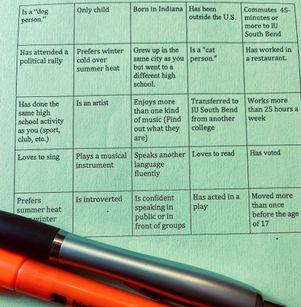-
About
Our Story
back- Our Mission
- Our Leadershio
- Accessibility
- Careers
- Diversity, Equity, Inclusion
- Learning Science
- Sustainability
Our Solutions
back
-
Community
Community
back- Newsroom
- Discussions
- Webinars on Demand
- Digital Community
- The Institute at Macmillan Learning
- English Community
- Psychology Community
- History Community
- Communication Community
- College Success Community
- Economics Community
- Institutional Solutions Community
- Nutrition Community
- Lab Solutions Community
- STEM Community
- Newsroom
You Belong Here.
- Subscribe to RSS Feed
- Mark as New
- Mark as Read
- Bookmark
- Subscribe
- Printer Friendly Page
- Report Inappropriate Content
I don’t know when we’ll start an academic year without reflecting on the impact of the pandemic, but this is not yet that year.
This semester is the first time since March 2020 that I have taught without a mask in a classroom, and it still feels odd. I keep forgetting to floss after lunch and before teaching. (Masks had ancillary virtues!) While many of our incoming first-year students had some semblance of a “normal” senior year of high school, they still seem to be stumbling through social interactions. I asked my new students how many of them consider themselves to be introverts, and every single person raised a hand. I waved my arms like a conductor, inviting them to take in the data in the room. “See? We’re all in this weirdness together.” They laughed, nervously.
How can we, in our writing classrooms, best rise to this occasion?
Our campus theme for first-year students seeks to address this challenge: “You belong here. You can do this. We are here to help.” Those sentiments may feel too pat—too easy. If you are reading this, however, you are likely someone who is thoughtful about putting those claims into action for your students.

In our book, From Inquiry to Academic Writing, co-authored with Stuart Greene, we introduce students to the “Rogerian” approach to argument, based on psychologist Carl Rogers’ theories. Rogers guides us to reduce the sense of threat in a conversational encounter in order to open the possibility of finding common ground. For writers, this means:
- Conveying to readers that their different views are understood;
- Acknowledging conditions under which readers’ views are valid;
- Helping readers see that the writer shares common ground with them;
- Creating mutually acceptable solutions to agreed-on problems.
When students practice empathetic encounters in classroom conversation, we help them see that their voices matter, that they will be listened to, and that they belong on our campus and in academic conversations. Practicing Rogerian moves helps students see these moves in other writers’ texts, and helps them use them in their own writing. Certainly, I hope we are also offering students skills that are much-needed far beyond our classrooms.
While we’re already a couple weeks into our semester, we continue to start class with connection and conversation activities, such as having students count themselves off into different small groups and asking them to find 3 or 4 traits in common in 3-4 minutes (extra props for the more unusual commonalities). These not only serve as ice-breakers, but also help students see the value of finding common ground. I’d include here the value of communal laughter, as students discover they share a love of the same flavor-blasted snacks, brand of hot sauce, or number of tattoos. Sure, these activities “take up time,” but they are an investment in the whole semester (and beyond, as friendships spark). These conversations are a reminder that when we write, we write for real readers who want to be persuaded, not bullied or lectured, and with whom we might have much in common.
What strategies work for you as you help students see the value of empathy and finding common ground as we help them settle into yet another weird year?
You must be a registered user to add a comment. If you've already registered, sign in. Otherwise, register and sign in.






